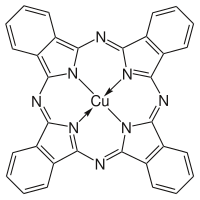
Photo from wikipedia
Abstract Copper(II)phthalocyanine-incorporated metal organic framework (CuPc/MOF) composite material was synthesized for application as an electrocatalyst for hydrogen evolution reaction (HER). The composite exhibited excellent electroactivity compared to the unmodified MOF,… Click to show full abstract
Abstract Copper(II)phthalocyanine-incorporated metal organic framework (CuPc/MOF) composite material was synthesized for application as an electrocatalyst for hydrogen evolution reaction (HER). The composite exhibited excellent electroactivity compared to the unmodified MOF, as confirmed by the diffusion coefficients (D) values of 3.89 × 10−7 and 1.57 × 10−6 cm2 s−1 for MOF and CuPc/MOF, respectively. The D values were determined from cyclic voltammetry (CV) experiments performed in 0.1 mol L−1 tetrabutylammonium perchlorate/dimethyl sulfoxide (TBAP/DMSO) electrolyte. The Tafel slope determined from the CV data of CuPc/MOF-catalysed HER for 0.450 mol L−1 H2SO4, was 176.2 mV dec−1, which was higher than that of the unmodified MOF (158.3 mV dec−1). The charge transfer coefficients of MOF and CuPc/MOF were close to 0.5, signifying the occurrence of a Volmer reaction involving either the Heyrovsky or the Tafel mechanism for hydrogen generation. For both MOF and CuPc/MOF, the exchange current density (i0) improved with increase in the concentration of the hydrogen source (i.e. 0.033–0.45 mol L−1 H2SO4) Nonetheless, the CuPc/MOF composite had a higher i0 value compared with the unmodified MOF. Thus CuPc/MOF has promise as an efficient electrocatalyst for HER.
Journal Title: International Journal of Hydrogen Energy
Year Published: 2019
Link to full text (if available)
Share on Social Media: Sign Up to like & get
recommendations!